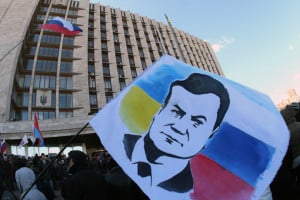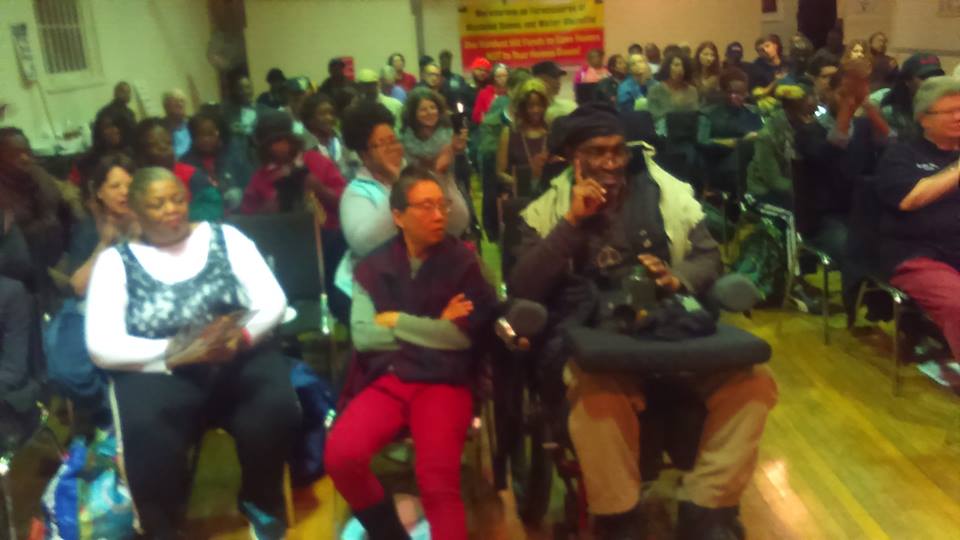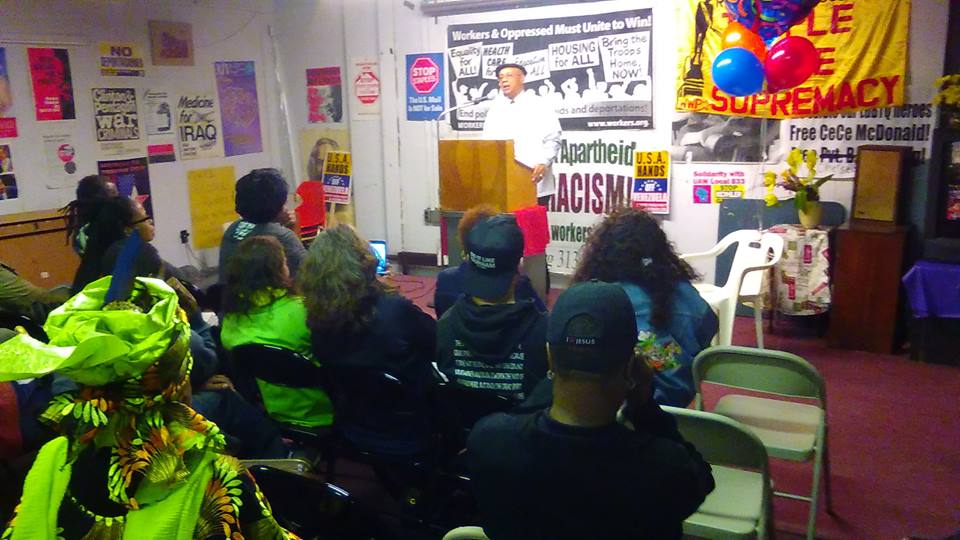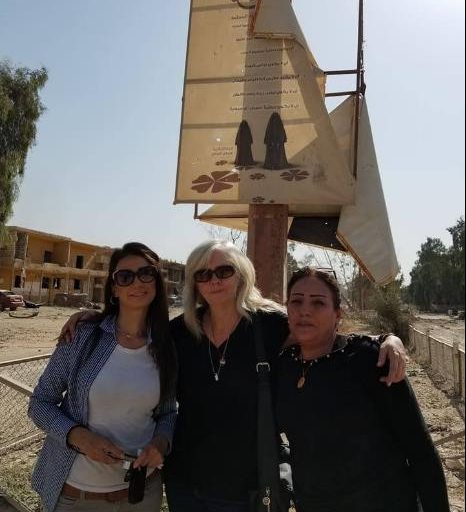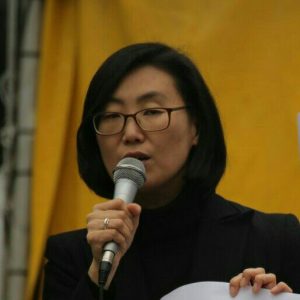According to the World Health Organization (WHO):
As societies industrialize and the technological revolution continues, there has been an unprecedented increase in the number and diversity of electromagnetic field (EMF) sources. These sources include video display units (VDUs) associated with computers, mobile phones and their base stations. While these devices have made our life richer, safer and easier, they have been accompanied by concerns about possible health risks due to their EMF emissions.
For some time a number of individuals have reported a variety of health problems that they relate to exposure to EMF. While some individuals report mild symptoms and react by avoiding the fields as best they can, others are so severely affected that they cease work and change their entire lifestyle. This reputed sensitivity to EMF has been generally termed “electromagnetic hypersensitivity” or EHS.
Other sources of this type of radiation include power lines and WiFi technology.
The WHO fact sheet quoted above also describes Electromagnetic Hypersensitivity in detail, and is based on the combined research of a WHO Workshop on the subject (Prague, Czech Republic, 2004), an international conference on EMF and non-specific health symptoms (COST244bis, 1998), a European Commission report (Bergqvist and Vogel, 1997), and recent reviews of the literature.
However, many of the facts cited seem to be countered by a growing number of publications and scientists. For example, they argue that EMFs are simply a “perceived” problem, and the sensitivities are psychological rather than physical. They state that “well controlled and conducted double-blind studies have shown that symptoms were not correlated with EMF exposure.” They also state it’s possible “these symptoms may be due to pre-existing psychiatric conditions as well as stress reactions as a result of worrying about EMF health effects, rather than the EMF exposure itself.” In conclusion, they suggest that “treatment of affected individuals should focus on the health symptoms and the clinical picture, and not on the person’s perceived need for reducing or eliminating EMF in the workplace or home.”
These arguments are reminiscent of those surrounding Glyphosate, the main ingredient in Monsanto’s Round Up herbicide, because for decades a plethora of publications and scientists were showing what it can do to the human body, yet it wasn’t until recently that the World Health Organization admitted that it is carcinogenic. Why does it take so long for new evidence to be considered? Why do they state that substances are safe in the face of such staunch opposition from so many professionals, and why do we assume things are safe until proven otherwise? Shouldn’t it be the other way around? Are we seeing the same thing with electromagnetic radiation?
If It’s Not A Concern, Then Why…
If it’s not as much of a concern as many feel it to be, then why are more than 200 scientists from more than 40 countries petitioning the United Nations about this issue? The information above provided from the WHO is more than a decade old, and in 2015 this group of scientists urged the United Nations and its organization to encourage precautionary measures and conduct an environmental assessment. They also asked for the WHO to educate the public about health risks, particularly to children and pregnant women, and for the United Nations Environmental Programme (UNEP) to assess the potential impact of EMF exposure on all living organisms.
Why are there more than 2,000 peer-reviewed publications raising cause for concern on this topic? According to the appeal sent to Antonio Guterres (among others), Secretary-General of the United Nations:
Numerous scientific publications have found that EMF affects living organisms at levels far below international exposure guidelines adopted by most industrialized nations. There is discrepancy in how this matter is considered at the WHO, however. While WHO accepted its International Agency for Research on Cancer (IARC)’s recommendation that classifies both ELF/EMF and RF/EMF as Group 2B “Possible Carcinogens,” it also, in direct contrast to these warnings, recommends the adoption of the International Commission on Non-Ionizing Radiation Protection’s (ICNIRP) guidelines for exposure standards. These guidelines, developed by a self-selected 2 independent industry group, have long been criticized as not protective given the science now established.
“Independent Industry Group”
The importance of highlighting industry’s role in this matter shouldn’t be ignored, since modern day science is, unfortunately, plagued by industry corruption and scientific fraud. Not long ago, however, the Berkeley City Council unanimously adopted an ordinance to require cellphone retailers in Berkeley, California, to provide consumers with information regarding the dangers associated with the wireless industry and, more specifically, on cell phone radiation.
It specifically requires all cellphone retailers in the area to provide consumers with a notice on radio frequency (RF) radiation exposure and the proper guidelines to help users avoid this type of exposure. Warnings may include the dangers associated with carrying a phone tucked into a shirt, pants, bra, or anywhere else on a person that may exceed federal safety guidelines.
The ordinance was created with the help of Lawrence Lessig, a law professor at Harvard University, the California Brain Tumor Association, and Robert Post, the Dean of Yale Law School, who believes, along with hundreds of other scientists, that the research is sound.
The concerns raised by all of these scientists also had at least 12 elementary and middle schools in Ontario and B.C. impose bans on wireless internet by not installing it or removing it completely from their classrooms. You can read more about that here.
Hearing From the Creator of the Initiative
The initiative was started by Dr. Martin Blank, Ph.D., from the Department of Physiology and Cellular Biophysics at Colombia University, who has joined a group of scientists from around the world making an international appeal to the United Nations regarding the dangers associated with the use of various electromagnetic emitting devices, like cells phones and WiFi.
“Putting it bluntly they are damaging the living cells in our bodies and killing many of us prematurely,”said Dr. Martin Blank, from the Department of Physiology and Cellular Biophysics at Columbia University, in a video message.
“We have created something that is harming us, and it is getting out of control. Before Edison’s light bulb there was very little electromagnetic radiation in our environment. The levels today are very many times higher than natural background levels, and are growing rapidly because of all the new devices that emit this radiation.”
Below is a video of him speaking about this issue.
Do You Have Electromagnetic Sensitivity? What Can You Do About It?
For starters, the best think you can do is not to worry, because this is how powerful the mind-body connection really is.
It’s also important to mention that children’s brains absorb much more radiation than those of adults. According to Mary Redmayne, Ph.D,. a professor in the Department of Epidemiology & Preventative Medicine at Australia’s Monash University:
There is much high-quality research showing bio-physiological effects from permitted electromagnetic exposures; these findings are not nullified by research which fails to find effects. To claim that the ‘weight of evidence’ does not support these effects (even if it were true) is misleading. To infer that this means no precautions are needed is illogical and non-scientific.
It would help parents and policy makers if consensus among advisory organisations and scientists could be reached acknowledging that assurance of safety of chronic low-dose radiofrequency exposure cannot be guaranteed and is related to ill-health in some people. Therefore, minimising exposure, especially children’s, is sensible. This should be treated like other daily health precautions and warnings such as those about diet.
A publication from the International Commission on Non-Ionizing Radiation Protection, titled “Guidelines For Limiting Exposure To Time Varying Electric, Magnetic, and Electromagnetic Fields Up To 300 GHZ,” cites an abundance of scientific research regarding these non-natural fields and their affect on human biology.
Here are the IARC’s Monographs on the Evaluation of Carcinogenic Risks to Humans.
The symptoms can differ a lot between sufferers, but will normally include some of the following: sleep disturbance, tiredness, depression, headaches, restlessness, irritability, concentration problems, forgetfulness, learning difficulties, frequent infections, blood pressure changes, limb and joint pains, numbness or tingling sensations, tinnitus, hearing loss, impaired balance, giddiness and eye problems. There have been reports of cardiovascular problems such as tachycardia, though these are relatively rare.
Many of the symptoms reported resemble those of multiple chemical sensitivity (MCS).
Some steps you can take are:
- Don’t let your child use a cell phone.
- Keep your cell phone use to a minimum.
- Reduce or eliminate your use of other wireless devices.
- Limit cell phone use to areas with excellent reception.
- Avoid carrying your cell phone on your body, and do not sleep with it under your pillow or near your head.
- Don’t assume one cell phone is safer than another. There’s no such thing as a “safe” cell phone.
- Respect others; many are highly sensitive to EMF. Some people who have become sensitive can feel the effects of others’ cell phones in the same room, even when it is on but not being used.
- Walk barefoot on the earth
- Worry less. The power of consciousness with regards to our health is huge. This has been demonstrated by recent findings within quantum physics, the placebo effect, and many other interesting phenomena, like neuro-plasticity. This could explain why some people who have such unhealthy lifestyles, but don’t worry and enjoy themselves still live longer. The human body is great at adapting — all we have to do is help it out a little bit.
You can also check out Dr. Scott Eberle, who trained as a family physician, worked for nearly two decades as an AIDS specialist, and continues as a hospice medical director. After an episode of carbon monoxide poisoning in 2010, he began having symptoms that, in retrospect, signalled the initial onset of this type of sensitivity. In 2013, his health plummeted until he finally figured out the cause.
“What’s the Diagnosis, Doctor?” was published in Sonoma Medicine in 2104. “An Underworld Journey: Learning to Cope With Electromagnetic Sensitivity” was published by Ecopsychology in 2017. See also: “So You Think You Might Be Electrosensitive “and “Guidelines for Making a Home Radiowave Safe.” Read more from Dr. Eberle here.
Devices You Can Get to Help Protect You, Backed by Science
As a result of this growing issue that’s gaining more attention, scientists and researchers are now teaming up to find ways to mitigate the effects of electromagnetic radiation. One example would be the devices manufactured by Earth-Calm. They have been tested in the lab by multiple scientists, with full reports and results available on the website.
I just wanted to provide an example, and let people know that there are several companies developing these products. I recommend doing the research, reading the studies and results, as well as contacting the scientists who are conducting these studies.
2,000+ Peer-Reviewed Studies
The truth is, there are more, but these 2,000 come from the 200+ scientists who are petitioning the UN about this issue, as mentioned above. Below is the list. Feel free to look them up and contact them for more information.
Armenia
Prof. Sinerik Ayrapetyan, Ph.D., UNESCO Chair – Life Sciences International Postgraduate Educational Center, Armenia
Australia
Dr. Priyanka Bandara, Ph.D., Independent Env.Health Educator/Researcher, Advisor, Environmental Health Trust; Doctors for Safer Schools, Australia
Dr. Peter French BSc, MSc, MBA, PhD, FRSM, Conjoint Senior Lecturer, University of New South Wales, Australia
Dr. Bruce Hocking, MD, MBBS, FAFOEM (RACP), FRACGP, FARPS, specialist in occupational medicine; Victoria, Australia
Dr. Gautam (Vini) Khurana, Ph.D., F.R.A.C.S., Director, C.N.S. Neurosurgery, Australia
Dr. Don Maisch, Ph.D., Australia
Dr. Elena Pirogova, Ph.D., Biomed Eng., B. Eng (Hon) Chem. Eng., Engineering & Health College; RMIT University, Australia
Dr. Mary Redmayne, Ph.D., Department of Epidemiology & Preventive Medicine, Monash University, Australia
Dr. Charles Teo, BM, BS, MBBS, Member of the Order of Australia, Director, Centre for Minimally Invasive Neurosurgery at Prince of Wales Hospital, NSW, Australia
Austria
Dr. Michael Kundi, MD, University of Vienna, Austria
Dr. Gerd Oberfeld, MD, Public Health Department, Salzburg Government, Austria
Dr. Bernhard Pollner, MD, Pollner Research, Austria
Prof. Dr. Hugo W. Rüdiger, MD, Austria
Bahrain
Dr. Amer Kamal, MD, Physiology Department, College of Medicine, Arabian Gulf University, Bahrain
Belgium
Prof. Marie-Claire Cammaerts, Ph.D., Free University of Brussels, Faculty of Science, Brussels, Belgium
Brazil
Vânia Araújo Condessa, MSc., Electrical Engineer, Belo Horizonte, Brazil
Prof. Dr. João Eduardo de Araujo, MD, University of Sao Paulo, Brazil
Dr. Francisco de Assis Ferreira Tejo, D. Sc., Universidade Federal de Campina Grande, Campina Grande, State of Paraíba, Brazil
Prof. Alvaro deSalles, Ph.D., Federal University of Rio Grande Del Sol, Brazil
Prof. Adilza Dode, Ph.D., MSc. Engineering Sciences, Minas Methodist University, Brazil
Dr. Daiana Condessa Dode, MD, Federal University of Medicine, Brazil
Michael Condessa Dode, Systems Analyst, MRE Engenharia Ltda, Belo Horizonte, Brazil
Prof. Orlando Furtado Vieira Filho, PhD, Cellular&Molecular Biology, Federal University of Rio Grande do Sul, Brazil
Canada
Dr. Magda Havas, Ph.D., Environmental and Resource Studies, Centre for Health Studies, Trent University, Canada
Dr. Paul Héroux, Ph.D., Director, Occupational Health Program, McGill University; InvitroPlus Labs, Royal Victoria Hospital, McGill University, Canada
Dr. Tom Hutchinson, Ph.D., Professor Emeritus, Environmental and Resource Studies, Trent University, Canada
Prof. Ying Li, Ph.D., InVitroPlus Labs, Dept. of Surgery, Royal Victoria Hospital, McGill University, Canada
James McKay M.Sc, Ecologist, City of London; Planning Services, Environmental and Parks Planning, London, Canada
Prof. Anthony B. Miller, MD, FRCP, University of Toronto, Canada
Prof. Klaus-Peter Ossenkopp, Ph.D., Department of Psychology (Neuroscience), University of Western Ontario, Canada
Dr. Malcolm Paterson, PhD. Molecular Oncologist (ret.), British Columbia, Canada
Prof. Michael A. Persinger, Ph.D., Behavioural Neuroscience and Biomolecular Sciences, Laurentian University, Canada
China
Prof. Huai Chiang, Bioelectromagnetics Key Laboratory, Zhejiang University School of Medicine, China
Prof. Yuqing Duan, Ph.D., Food & Bioengineering, Jiangsu University, China
Dr. Kaijun Liu, Ph.D., Third Military Medical University, Chongqing, China
Prof. Xiaodong Liu, Director, Key Lab of Radiation Biology, Ministry of Health of China; Associate Dean, School of Public Health, Jilin University, China
Prof. Wenjun Sun, Ph.D., Bioelectromagnetics Key Lab, Zhejiang University School of Medicine, China
Prof. Minglian Wang, Ph.D., College of Life Science & Bioengineering, Beijing University of Technology, China
Prof. Qun Wang, Ph.D., College of Materials Science & Engineering, Beijing University of Technology, China
Prof. Haihiu Zhang, Ph.D., School of Food & BioEngineering, Jiangsu University, China
Prof. Jianbao Zhang, Associate Dean, Life Science and Technology School, Xi’an Jiaotong University, China
Prof. Hui-yan Zhao, Director of STSCRW, College of Plant Protection, Northwest A & F University, Yangling Shaanxi, China
Prof. J. Zhao, Department of Chest Surgery, Cancer Center of Guangzhou Medical University, Guangzhou, China
Croatia
Ivancica Trosic, Ph.D., Institute for Medical Research and Occupational Health, Croatia
Egypt
Prof. Dr. Abu Bakr Abdel Fatth El-Bediwi, Ph.D., Physics Dept., Faculty of Science, Mansoura University, Egypt
Prof. Dr. Emad Fawzy Eskander, Ph.D., Medical Division, Hormones Department, National Research Center, Egypt
Prof. Dr. Heba Salah El Din Aboul Ezz, Ph.D., Physiology, Zoology Department, Faculty of Science, Cairo University, Egypt
Prof. Dr. Nasr Radwan, Ph.D., Neurophysiology, Faculty of Science, Cairo University, Egypt
Estonia
Dr. Hiie Hinrikus, Ph.D., D.Sc, Tallinn University of Technology, Estonia
Mr. Tarmo Koppel, Tallinn University of Technology, Estonia
Finland
Dr. Mikko Ahonen, Ph.D, University of Tampere, Finland
Dr. Marjukka Hagström, LL.M., M.Soc.Sc, Principal Researcher, Radio and EMC Laboratory, Finland
Prof. Dr. Osmo Hänninen, Ph.D., Dept. of Physiology, Faculty of Medicine, University of Eastern Finland, Finland; Editor-In-Chief, Pathophysiology, Finland
Dr. Dariusz Leszczynski, Ph.D., Adjunct Professor of Biochemistry, University of Helsinki, Finland; Member of the IARC Working Group that classified cell phone radiation as possible carcinogen.
Dr. Georgiy Ostroumov, Ph.D. (in the field of RF EMF), independent researcher, Finland
France
Prof. Dr. Dominique Belpomme, MD, MPH, Professor in Oncology, Paris V Descartes University, ECERI Executive Director
Dr. Pierre Le Ruz, Ph.D., Criirem, Le Mans, France Georgia
Prof. Besarion Partsvania, Ph.D., Head of Bio-cybernetics Department of Georgian Technical University, Georgia
Germany
Prof. Dr. Franz Adlkofer, MD, Chairman, Pandora Foundation, Germany
Prof. Dr. Hynek Burda, Ph.D., University of Duisburg-Essen, Germany
Dr. Horst Eger, MD, Electromagnetic Fields in Medicine, Association of Statutory Health Insurance Physicians, Bavaria, Germany
Prof. Dr. Karl Hecht, MD, former Director, Institute of Pathophysiology, Charité, Humboldt University, Berlin, Germany
Dr.Sc. Florian M. König, Ph.D., Florian König Enterprises (FKE) GmbH, Munich, Germany
Dr. rer. nat. Lebrecht von Klitzing, Ph.D., Dr. rer. nat. Lebrecht von Klitzing, Ph.D., Head, Institute of Environ.Physics; Ex-Head, Dept. Clinical Research, Medical University, Lubeck, Germany
Dr. Cornelia Waldmann-Selsam, MD, Member, Competence Initiative for the Protection of Humanity, Environment and Democracy e.V, Bamberg, Germany
Dr. Ulrich Warnke, Ph.D., Bionik-Institut, University of Saarlandes, Germany
Greece
Dr. Adamantia F. Fragopoulou, M.Sc., Ph.D., Department of Cell Biology & Biophysics, Biology Faculty, University of Athens, Greece
Dr. Christos Georgiou, Ph.D., Biology Department, University of Patras, Greece
Prof. Emeritus Lukas H. Margaritis, Ph.D., Depts. Cell Biology, Radiobiology & Biophysics, Biology Faculty, Univ. of Athens, Greece
Dr. Aikaterini Skouroliakou, M.Sc., Ph.D., Department of Energy Technology Engineering, Technological Educational Institute of Athens, Greece
Dr. Stelios A Zinelis, MD, Hellenic Cancer Society-Kefalonia, Greece
Iceland
Dr. Ceon Ramon, Ph.D., Affiliate Professor, University of Washington, USA; Professor, Reykjavik University, Iceland
India
Prof. Dr. B. D. Banerjee, Ph.D., Fmr. Head, Environmental Biochemistry & Molecular Biology Laboratory, Department of Biochemistry, University College of Medical Sciences, University of Delhi, India
Prof. Jitendra Behari, Ph.D., Ex-Dean, Jawaharlal Nehru University; presently, Emeritus Professor, Amity University, India
Prof. Dr. Madhukar Shivajirao Dama, Institute of Wildlife Veterinary Research, India
Associate Prof. Dr Amarjot Dhami, PhD., Lovely Professional University, Phagwara, Punjab, India
Dr. Kavindra K. Kesari, MBA, Ph.D., Resident Environmental Scientist, University of Eastern Finland, Finland; Assistant Professor, Jaipur National University, India
Prof. Girish Kumar, Ph.D., Electrical Engineering Department, Indian Institute of Technology, Bombay, India
Dr. Pabrita Mandal PhD.,Department of Physics, Indian Institute of Technology, Kanpur, India
Prof. Rashmi Mathur, Ph.D., Head, Department of Physiology, All India Institute of Medical Sciences, New Delhi, India
Prof. Dr. Kameshwar Prasad MD, Head, Dept of Neurology, Director, Clinical Epidemiology, All India Institute of Medical Sciences, India
Dr. Sivani Saravanamuttu, PhD., Dept. Advanced Zoology and Biotechnology, Loyola College, Chennai, India
Dr. N.N. Shareesh, PhD., Melaka Manipal Medical College, India
Dr. R.S. Sharma, MD, Sr. Deputy Director General, Scientist – G & Chief Coordinator – EMF Project, Indian Council of Medical Research, Dept. of Health Research, Ministry/Health and Family Welfare, Government of India, New Delhi, India
Prof. Dr. Dorairaj Sudarsanam, M.Sc., M.Ed., Ph.D., Fellow – National Academy of Biological Sciences, Prof. of Zoology, Biotechnology and Bioinformatics, Dept. Advanced Zoology & Biotechnology, Loyola College, Chennai, South India
Iran (Islamic Republic of)
Prof. Dr. Soheila Abdi, Ph.D., Physics, Islamic Azad University of Safadasht, Tehran, Iran
Prof. G.A. Jelodar, D.V.M., Ph.D., Physiology, School of Veterinary Medicine, Shiraz University, Iran
Prof. Hamid Mobasheri, Ph.D., Head BRC; Head, Membrane Biophysics&Macromolecules Lab; Instit. Biochemistry&Biophysics, University, Tehran, Iran
Prof. Seyed Mohammad Mahdavi, PhD., Dept of Biology, Science and Research, Islamic Azad University, Tehran, Iran
Prof. S.M.J. Mortazavi, Ph.D., Head, Medical Physics & Engineering; Chair, NIER Protection Research Center, Shiraz University of Medical Sciences, Iran
Prof. Amirnader Emami Razavi, Ph.D., Clinical Biochem., National Tumor Bank, Cancer Institute, Tehran Univ. Medical Sciences, Iran
Dr. Masood Sepehrimanesh, Ph.D., Gastroenterohepatology Research Center, Shiraz University of Medical Sciences, Iran
Prof. Dr. Mohammad Shabani, Ph.D., Neurophysiology, Kerman Neuroscience Research Center, Iran
Israel
Michael Peleg, M.Sc., radio communications engineer and researcher, Technion – Israel Institute of Technology, Israel
Prof. Elihu D. Richter, MD,MPH, Occupational&Environmental Medicine, Hebrew University-Hadassah School of Public Health&Community Medicine, Israel
Dr. Yael Stein, MD, Hebrew University of Jerusalem, Hadassah Medical Center, Israel
Dr. Danny Wolf, MD, Pediatrician and General Practitioner, Sherutey Briut Clalit, Shron Shomron district, Israel
Dr. Ronni Wolf, MD, Assoc. Clinical Professor, Head of Dermatology Unit, Kaplan Medical Center, Rehovot, Israel
Italy
Prof. Sergio Adamo, Ph.D., La Sapienza University, Rome, Italy
Prof. Fernanda Amicarelli, Ph.D., Applied Biology, Dept. of Health, Life and Environmental Sciences, University of L’Aquila, Italy
Dr. Pasquale Avino, Ph.D., INAIL Research Section, Rome, Italy
Dr. Fiorella Belpoggi, Ph.D., FIATP, Director, Cesare Maltoni Cancer Research Center, Ramazzini Institute, Italy
Prof. Giovanni Di Bonaventura, PhD, School of Medicine, “G. d’Annunzio” University of Chieti-Pescara, Italia
Prof. Emanuele Calabro, Department of Physics and Earth Sciences, University of Messina, Italy
Prof. Franco Cervellati, Ph.D., Department of Life Science and Biotechnology, Section of General Physiology, University of Ferrara, Italy
Vale Crocetta, Ph.D. Candidate, Biomolecular and Pharmaceutical Sciences, “G. d’Annunzio” University of Chieti, ItalyProf. Stefano Falone, Ph.D., Researcher in Applied Biology, Dept. of Health, Life&Environmental Sciences, University of L’Aquila, Italy
Prof. Dr. Speridione Garbisa, ret. Senior Scholar, Dept. Biomedical Sciences, University of Padova, Italy
Dr. Settimio Grimaldi, Ph.D., Associate Scientist, National Research Council, Italy
Prof. Livio Giuliani, Ph.D., Director of Research, Italian Health National Service, Rome-Florence-Bozen; Spokesman, ICEMS-International Commission for Electromagnetic Safety, Italy
Prof. Dr. Angelo Levis, MD, Dept. Medical Sciences, Padua University, Italy
Prof. Salvatore Magazù, Ph.D., Department of Physics and Science, Messina University, Italy
Dr. Fiorenzo Marinelli, Ph.D., Researcher, Molecular Genetics Institute of the National Research Council, Italy
Dr. Arianna Pompilio, PhD, Dept. Medical, Oral & Biotechnological Sciences. G. d’Annunzio University of Chieti-Pescara, Italy
Prof. Dr. Raoul Saggini, MD, School of Medicine, University G. D’Annunzio, Chieti, Italy
Dr. Morando Soffritti, MD, Honorary President, National Institute for the Study and Control of Cancer and Environmental Diseases, B.Ramazzini, Bologna. ItalyProf. Massimo Sperini, Ph.D., Center for Inter-University Research on Sustainable Development, Rome, Italy
Japan
Prof. Tsuyoshi Hondou, Ph.D., Graduate School of Science, Tohoku University, Japan
Prof. Hidetake Miyata, Ph.D., Department of Physics, Tohoku University, Japan
Jordan
Prof. Mohammed S.H. Al Salameh, Jordan University of Science & Technology , Jordan
Kazakhstan
Prof. Dr, Timur Saliev, MD, Ph.D., Life Sciences, Nazarbayev University, Kazakhstan; Institute Medical Science/Technology, University of Dundee, UK
New Zealand
Dr. Bruce Rapley, BSc, MPhil, Ph.D., Principal Consulting Scientist, Atkinson & Rapley Consulting Ltd., New Zealand
Nigeria
Dr. Idowu Ayisat Obe, Department of Zoology, Faculty of Science, University of Lagos, Akoka, Lagos, Nigeria
Prof. Olatunde Michael Oni, Ph.D, Radiation & Health Physics, Ladoke Akintola University of Technology, Ogbomoso, Nigeria
Oman
Prof. Najam Siddiqi, MBBS, Ph.D., Human Structure, Oman Medical College, Oman
Poland
Dr. Pawel Bodera, Pharm. D., Department of Microwave Safety, Military Institute of Hygiene and Epidemiology, Poland
Prof. Dr. Stanislaw Szmigielski, MD, Ph.D., Military Institute of Hygiene and Epidemiology, Poland
Romania
Alina Cobzaru, Engineer, National Institutes Research & Development and Institute of Construction & Sustainability, Romania
Russian Federation
Prof. Vladimir N. Binhi, Ph.D., A.M.Prokhorov General Physics Institute of the Russian Academy of Sciences; M.V.Lomonosov Moscow State University
Dr. Oleg Grigoyev, DSc., Ph.D., Deputy Chairman, Russian National Committee on Non-Ionizing Radiation Protection, Russian Federation
Prof. Yury Grigoryev, MD, Chairman, Russian National Committee on Non-Ionizing Radiation Protection, Russian Federation
Dr. Anton Merkulov, Ph.D., Russian National Committee on Non-Ionizing Radiation Protection, Moscow, Russian Federation
Dr. Maxim Trushin, PhD., Kazan Federal University, Russia
Serbia
Dr. Snezana Raus Balind, Ph.D., Research Associate, Institute for Biological Research “Sinisa Stankovic”, Belgrade, Serbia
Prof. Danica Dimitrijevic, Ph.D., Vinca Institute of Nuclear Sciences, University of Belgrade, Serbia
Dr. Sladjana Spasic, Ph.D., Institute for Multidisciplinary Research, University of Belgrade, Serbia
Slovak Republic
Dr. Igor Belyaev, Ph.D., Dr.Sc., Cancer Research Institute, Slovak Academy of Science, Bratislava, Slovak Republic
South Korea (Republic of Korea)
Prof. Young Hwan Ahn, MD, Ph.D, Ajou University Medical School, South Korea
Prof. Kwon-Seok Chae, Ph.D., Molecular-ElectroMagnetic Biology Lab, Kyungpook National University, South Korea
Prof. Dr. Yoon-Myoung Gimm, Ph.D., School of Electronics and Electrical Engineering, Dankook University, South Korea
Prof. Dr. Myung Chan Gye, Ph.D., Hanyang University, South Korea
Prof. Dr. Mina Ha, MD, Dankook University, South Korea
Prof. Seung-Cheol Hong, MD, Inje University, South Korea
Prof. Dong Hyun Kim, Ph.D., Dept. of Otorhinolaryngology-Head and Neck Surgery, Incheon St. Mary’s Hospital, Catholic University of Korea, South Korea
Prof. Hak-Rim Kim, Dept.of Pharmacology, College of Medicine, Dankook University, South Korea
Prof. Myeung Ju Kim, MD, Ph.D., Department of Anatomy, Dankook University College of Medicine, South Korea
Prof. Jae Seon Lee, MD, Department of Molecular Medicine, NHA University College of Medicine, Incheon 22212, South Korea
Prof. Yun-Sil Lee, Ph.D., Ewha Woman’s University, South Korea
Prof. Dr. Yoon-Won Kim, MD, Ph.D., Hallym University School of Medicine, South Korea
Prof. Jung Keog Park, Ph.D., Life Science & Biotech; Dir., Research Instit.of Biotechnology, Dongguk University, South Korea
Prof. Sungman Park, Ph.D., Institute of Medical Sciences, School of Medicine, Hallym University, South Korea
Prof. Kiwon Song, Ph.D., Dept. of Chemistry, Yonsei University, South Korea
Spain
Prof. Dr. Miguel Alcaraz, MD, Ph.D., Radiology and Physical Medicine, Faculty of Medicine, University of Murcia, Spain
Dr. Alfonso Balmori, Ph.D., Biologist, Consejería de Medio Ambiente, Junta de Castilla y León, Spain
Prof. J.L. Bardasano, D.Sc, University of Alcalá, Department of Medical Specialties, Madrid, Spain
Dr. Claudio Gómez-Perretta, MD, Ph.D., La Fe University Hospital, Valencia, Spain
Prof. Dr. Miguel López-Lázaro, PhD., Associate Professor, Department of Pharmacology, University of Seville, Spain
Prof. Dr. Elena Lopez Martin, Ph.D., Human Anatomy, Facultad de Medicina, Universidad de Santiago de Compostela, Spain
Prof. Enrique A. Navarro, Ph.D., Department of Applied Physics and Electromagnetics, University of Valencia, Spain
Sweden
Dr. Michael Carlberg, MSc, Örebro University Hospital, Sweden
Dr. Lennart Hardell, MD, Ph.D., University Hospital, Örebro, Sweden
Prof. Olle Johansson, Ph.D., Experimental Dermatology Unit, Dept. of Neuroscience, Karolinska Institute, Sweden
Dr. Bertil R. Persson, Ph.D., MD, Lund University, Sweden
Senior Prof. Dr. Leif Salford, MD. Department of Neurosurgery, Director, Rausing Laboratory, Lund University, Sweden
Dr. Fredrik Söderqvist, Ph.D., Ctr. for Clinical Research, Uppsala University, Västerås, Sweden
Switzerland
Dr. phil. nat. Daniel Favre, A.R.A. (Association Romande Alerte, Switzerland
Taiwan (Republic of China)
Prof. Dr. Tsun-Jen Cheng, MD, Sc.D., National Taiwan University, Republic of China
Turkey
Prof. Dr. Mehmet Zülküf Akdağ, Ph.D., Department of Biophysics, Medical School of Dicle University, Diyarbakir, Turkey
Associate Prof.Dr. Halil Abraham Atasoy, MD, Pediatrics, Abant Izzet Baysal University, Faculty of Medicine, Turkey
Prof. Ayse G. Canseven (Kursun), Ph.D., Gazi University, Faculty of Medicine, Dept. of Biophysics, Turkey
Prof. Dr. Mustafa Salih Celik, Ph.D., Fmr. Head, Turkish Biophysical Society; Head, Biophysics Dept; Medical Faculty, Dicle Univ., Turkey
Prof. Dr. Osman Cerezci, Electrical-Electronics Engineering Department, Sakarya University, Turkey
Prof. Dr. Suleyman Dasdag, Ph.D., Dept. of Biophysics, Medical School of Dicle University, Turkey
Prof. Omar Elmas, MD, Ph.D., Mugla Sitki Kocman University, Faculty of Medicine, Department of Physiology, Turkey
Prof. Dr. Ali H. Eriş, MD, faculty, Radiation Oncology Department, BAV University Medical School, Turkey
Prof. Dr. Arzu Firlarer, M.Sc. Ph.D., Occupational Health & Safety Department, Baskent University, Turkey
Prof. Associate Prof. Ayse Inhan Garip, PdH., Marmara Univ. School of Medicine, Biophysics Department, Turkey
Prof. Suleyman Kaplan, Ph.D., Head, Department of Histology and Embryology, Medical School, Ondokuz Mayıs University, Samsun, Turkey.
Prof. Dr. Mustafa Nazıroğlu, Ph.D., Biophysics Dept, Medical Faculty, Süleyman Demirel University, Isparta, Turkey
Prof. Dr. Ersan Odacı, MD, Ph.D., Karadeniz Technical University, Medical Faculty, Trabzon, Turkey
Prof. Dr. Elcin Ozgur, Ph.D., Biophysics Department, Faculty of Medicine, Gazi University, Turkey
Prof. Dr. Selim Seker, Electrical Engineering Department, Bogazici University, Istanbul, Turkey
Prof. Dr. Cemil Sert, Ph.D., Department of Biophysics of Medicine Faculty, Harran University, Turkey
Prof. Dr. Nesrin Seyhan, B.Sc., Ph.D., Medical Faculty of Gazi University; Chair, Biophysics Dept; Director GNRK Ctr.; Panel Mbr, NATO STO HFM; Scientific Secretariat Member, ICEMS; Advisory Committee Member, WHO EMF, Turkey
Prof. Dr. Bahriye Sirav (Aral), PhD.,Gazi University Faculty of Medicine, Dept of Biophysics, Turkey
Ukraine
Dr. Oleg Banyra, MD, 2nd Municipal Polyclinic, St. Paraskeva Medical Centre, Ukraine
Prof. Victor Martynyuk, PhD., ECS “Institute of Biology”, Head of Biophysics Dept, Taras Shevchenko National University of Kiev, Ukraine
Prof. Igor Yakymenko, Ph.D., D.Sc., Instit. Experimental Pathology, Oncology & Radiobiology, National Academy of Sciences of Ukraine
United Kingdom
Michael Bevington, M.A., M.Ed., Chair of Trustees, ElectroSensitivity UK (ES-UK), UK
Mr. Roger Coghill, MA,C Biol, MI Biol, MA Environ Mgt; Member Instit.of Biology; Member, UK SAGE Committee on EMF Precautions, UK
Mr. David Gee, Associate Fellow, Institute of Environment, Health and Societies, Brunel University, UK
Dr. Andrew Goldsworthy BSc PhD, Lecturer in Biology (retired), Imperial College, London, UK
Emeritus Professor Denis L. Henshaw, PhD., Human Radiation Effects, School of Chemistry, University of Bristol, UK
Dr. Mae-Wan Ho, Ph.D., Institute of Science in Society, UK
Dr. Gerard Hyland, Ph.D., Institute of Biophysics, Neuss, Germany, UK
Dr. Isaac Jamieson, Ph.D., Biosustainable Design, UK
Emeritus Professor, Michael J. O’Carroll, PhD., former Pro Vice-Chancellor, University of Sunderland, UK
Mr. Alasdair Phillips, Electrical Engineer, UK
Dr. Syed Ghulam Sarwar Shah, M.Sc., Ph.D., Public Health Consultant, Honorary Research Fellow, BrunelUniversity London, UK
Dr. Sarah Starkey, Ph.D., independent neuroscience and environmental health research, UK
USA
Dr. Martin Blank, Ph.D., Columbia University, USA
Prof. Jim Burch, MS, Ph.D., Dept. of Epidemiology & Biostatistics, Arnold School of Public Health, University of South Carolina, USA
Prof. David O. Carpenter, MD, Director, Institute for Health and the Environment, University of New York at Albany, USA
Prof. Prof. Simona Carrubba, Ph.D., Biophysics, Daemen College, Women & Children’s Hospital of Buffalo Neurology Dept., USA
Dr. Zoreh Davanipour, D.V.M., Ph.D., Friends Research Institute, USA
Dr. Devra Davis, Ph.D., MPH, President, Environmental Health Trust; Fellow, American College of Epidemiology, USA
Paul Raymond Doyon, EMRS, MAT, MA , Doyon Independent Research Associates, USA
Prof. Om P. Gandhi, Ph.D., Department of Electrical and Computer Engineering, University of Utah, USA
Prof. Beatrice Golomb, MD, Ph.D., University of California at San Diego School of Medicine, USA
Dr. Martha R. Herbert, MD, Ph.D., Harvard Medical School, Harvard University, USA
Dr. Donald Hillman, Ph.D., Professor Emeritus, Michigan State University, USA
Elizabeth Kelley, MA, Fmr. Managing Secretariat, ICEMS, Italy; Director, EMFscientist.org, USA
Neha Kumar, Founder, Nonionizing Electromagnetic Radiation Shielding Alternatives, Pvt. Ltd; B.Tech – Industrial Biotech., USA
Dr. Henry Lai, Ph.D., University of Washington, USA
B. Blake Levitt, medical/science journalist, former New York Times contributor, EMF researcher and author, USA
Prof. Trevor G. Marshall, PhD, Autoimmunity Research Foundation, USA
Dr. Albert M. Manville, II, Ph.D. and C.W.B., Adj. Professor, Johns Hopkins University Krieger Graduate School of Arts & Sciences; Migratory Bird Management, U.S. Fish & Wildlife Service, USA
Dr. Andrew Marino, J.D., Ph.D., Retired Professor, LSU Health Sciences Center, USA
Dr. Marko Markov, Ph.D., President, Research International, Buffalo, New York, USA
Dr. Jeffrey L. Marrongelle, DC, CCN, President/Managing Partner of BioEnergiMed LLC, USA
Dr. Samuel Milham, MD, MPH, USA
L. Lloyd Morgan, Environmental Health Trust, USA
Dr. Joel M. Moskowitz, Ph.D., School of Public Health, University of California, Berkeley, USA
Dr. Martin L. Pall, Ph.D., Professor Emeritus, Biochemistry & Basic Medical Sciences, Washington State University, USA
Dr. Jerry L. Phillips, Ph.D. University of Colorado, USA
Dr. William J. Rea, M.D., Environmental Health Center, Dallas, Texas, USA
Camilla Rees, MBA, Electromagnetichealth.org; CEO, Wide Angle Health, LLC, USA
Prof. Narenda P. Singh, MD, University of Washington, USA
Prof. Eugene Sobel, Ph.D., Retired, School of Medicine, University of Southern California, USA
David Stetzer, Stetzer Electric, Inc., Blair, Wisconsin, USA
Dr. Lisa Tully, Ph.D., Energy Medicine Research Institute, Boulder, CO, USA
Supporting Scientists who have published peer reviewed papers in related fields
Michele Casciani, MA, Environmental Science, President/Chief Executive Officer, Salvator Mundi International Hospital, Rome, Italy
Enrico Corsetti, Engineer, Research Director, Salvator Mundi International Hospital, Rome, Italy
Jacques Testart, Biologist, Honorary Research Director at I.N.S.E.R.M. (French National Medical Research Institute), France
Xin Li, PhD candidate MSc, Department of Mechanical Engineering, Stevens Institute of Technology, New Jersey, USA
Dr. Carlos A. Loredo Ritter, MD, Pediatrician, Pediatric Neurologist, President, Restoration Physics, North American Sleep Medicine Society, USADr. Robin Maytum, PhD, Senior Lecturer in Biological Science, University of Bedfordshire, Luton, UK
Prof. Dr. Raúl A. Montenegro, Ph.D, Evolutionary Biology, National University of Cordoba; President, FUNAM; Recognitions: Scientific Investigation Award from University of Buenos Aires, UNEP ‘Global 500’ Award (Brussels, Belgium), the Nuclear Free Future Award (Salzburg, Austria), and Alternative Nobel Prize (Right Livelihood Award, Sweden), Argentina.
Dr. Georgiy Ostroumov, Ph.D. (in the field of RF EMF), independent researcher, Finland
Dr. Hugo Schooneveld, PhD, Biologist, Neuroscientist, Adviser to the Dutch EHS Foundation, Netherlands
Dr. Carmen Adella Sirbu, MD, Neurology, Lecturer, Titu Matorescu University, Romania

.jpg)








